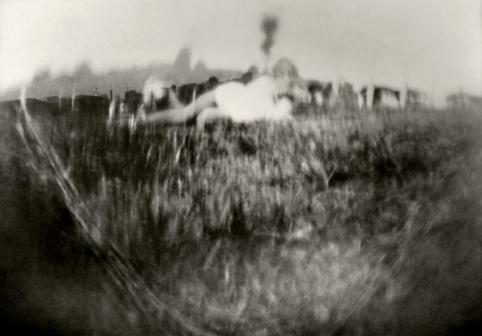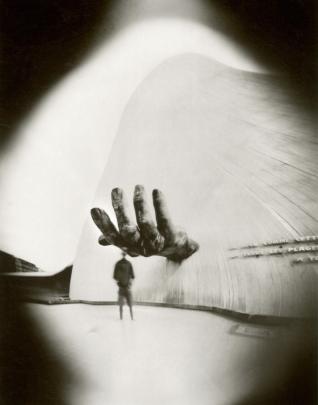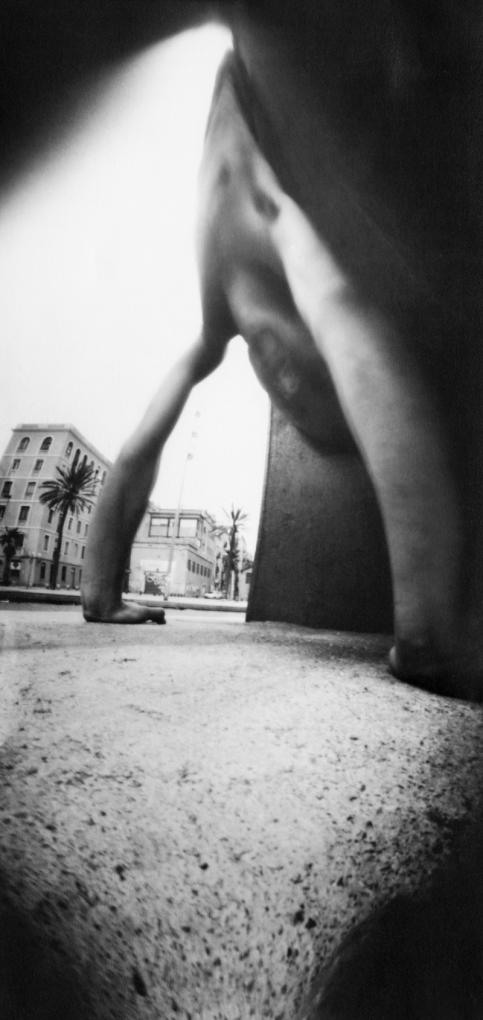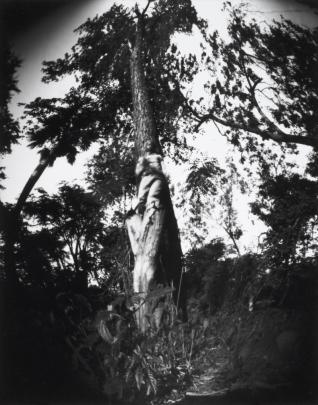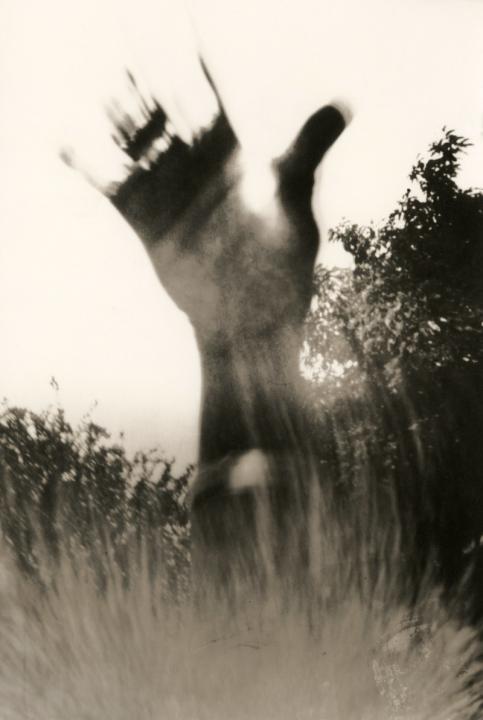The Oscura Association has been working to bring pinhole photography to the biggest audience possible since it was established in the early nineties. It is an easy process - all you need is a box, a hole and a photosensitive surface. The simplest version of the old-style camera obscura, the pinhole camera has been a means for the Oscura association to foster connections through almost one hundred workshops all over the world, for over 35 years, from Saint-Denis to Bamako, from Le Havre to Sarajevo.
Each of Oscura’s interventions are based on the seven characteristics presented in the exhibition: “In the box”, “Places to shoot”, “Air flow”, “Posing bodies”, “Slow and steady”, “Trans-Plantations”, “Border winds”. These characteristics form part of each workshop, and examine our relation to the world and its representation.
While today, it has never been easier to take photos, digital methods allow “perfection” when reproducing the real - a finger on a smartphone screen can capture what we are looking at in a split second - Oscura is re-examining the question of how photographic images are produced. Each participant in the Oscura workshops makes their own photographic chamber, chooses where to put the hole, commits to the long period of time of thinking about and choosing where to position the box and experiments with the way pictures are deformed by the shape of their “camera”.
Oscura’s field of interest, overlaps with that of the Musée Nicéphore Niépce, in as much as they both believe that photography cannot be reduced to a practice, a protocol, to any kind of certainty. We also agree that it is an amazing way to tell singular and collective stories.
Oscura: seven lessons
1/ IN THE BOX
Pinhole photography is a contemporary practice. Unlike the pioneers of photography who were looking to speed things up, the Oscura association promotes taking time in a hurried world. All of these time-images are collective, they affirm the existence of the other and of the self, they explore the aura of a new freedom in photography. Pinhole photography is also just a box with a little hole. Of course you can buy them, but Oscura always prefers to make them by hand, using iron boxes that resist the sun and the rain. The search for a box is already a journey of discovery through a territory and its habits. Biscuits, buttons and screws end up being rehoused. The size of the box determines the size of the photographic paper and, as such the photo itself. It takes time to choose where to pierce the hole in the box, on the side or on the top? Decisions, decisions. Then come the light experiments. Each attempt personalizes the chamber, a vignette, a reflection, a chance calculation…
2/ PLACES TO SHOOT
Once the box has been found, it is time to take over the space. Before taking the shot, the box has to be suspended, hung, overturned or taped. When handheld, the result is blurred and the lines shift. Taking a photo with a pinhole camera requires a real examination of the space you’re in to find where you want to place your box. It means looking for a stick or a rock to hold it up, seeking the hospitality of a branch, the edge of a wall or a fence. You must evaluate the choice of direction or lack thereof, the flexibility and resistance of a perch, the strength of the wind, and the path of the shadows or currents. And you have to remember that anything can happen, both inside and outside - a gust of wind, a fall, a bang, an attack by the elements.
3/ AIR FLOW
There is no lens on a pinhole camera. Once you have pierced the hole, the only things that vary are the intensity of the light and the emulsion. To better share the act of taking a photograph, Oscura chooses to work with photosensitive paper (black and white) as a negative. This means the pose time is long. Often, the body that is to be photographed is not prepared for the effort involved. It is used to instantaneous clicks, so it poses and is then surprised it cannot retain the pose. New trainers, lipstick and Sunday clothes are all very well, but they cannot prevent the body from slipping, shifting, twitching and stretching. When it finally comes to the realization, posing becomes a struggle against time. It is often too late. The print retains the traces of the struggle.
4/ POSING BODIES
Then the pose turns into a pause. Anyone who wants to take a portrait will have to get used to the long seconds during which the muscles lengthen or stretch in a temporal parenthesis. Shifting away from the instantaneous, the self-portrait blooms out of time. Our thoughts come together in a strange dialogue with ourselves or with what is already the future of another person. The body searches for comfort, looks for support, leans or lies down. It rests. It is ready to travel through and against time. A journey begins through the darkness of the camera, open to the heart and the body. The very places where these pauses occur break free from the everyday.
5/ SLOW AND STEADY
As time goes on, the risks in the time lapse become a need, an adventure causing upheaval in the limits of conscience and perception. While the pinhole is open, in the confusion of nights and days, the lines and surfaces of the bodies can tend to melt. After delicately posing a box on the wardrobe, a body gets in the bed and dreams of the sympathetic inscription of a silent desire, and in the morning, closes the covers like a book still being written, without an author. In the cellar, the day goes by listening to will-o’-the-wisps, no one knows where they come from, or where they go to hide when the fermentation groans. While the bakers’ dough rises, an obsession with the machines is the only thing that evokes the dawn work, while in the angle of the cloister, the prayers pile up so that time can finally rest.
6/ TRANS-PLANTATIONS
The relationship between the volume of the box and the size of the hole affect the depth of field and offer a multitude of options for the shots. In the beginning, Oscura wanted to calculate this fundamental and harmonious relationship precisely in order to generate the best possible diaphragm. It is said that, when pushed to the extreme, this relationship can allow certain astronomers to access infinite depths of field, making possible observations that can’t be made on the very best telescopes. The first steps are often dedicated to this quest for exactitude. Leaving the big horizon behind, Oscura instead got up close, revealing the most intimate depths, from narrow streets in Naples to closed courtyards in Mopti or fragile caravans in Shutka. A pinhole lets you travel to strange fields and perspectives.
7/ BORDER WINDS
Using a pinhole camera can lead to confusion between the inside and the outside. Proportions don’t matter as it acts like a kiss between two worlds that must be kept apart. Surprisingly, stone turns to flesh and we slide down a hand, climb up a foot, jump from finger to finger, to finally get to a leaf that will make a good hammock. This world knows how to take the small and make it big. It deforms nothing, it merely exaggerates. The cartography of a pinhole camera knows nothing of the compass and the metric scale of distances. By distorting and folding space, to the point of excess, it is the best way to escape from what we know. Pinhole cameras allow us to go through the looking glass of photography
Read more about the story of Oscura, 1990-2024 on the museum’s website.
Publication in tandem with this exhibition:
Oscura
éditions le bec en l’air
ISBN 978-2-36744-190-0
36 euros
This publication was sponsored by the city of Chalon-sur-Saône and the French Ministry of Culture


